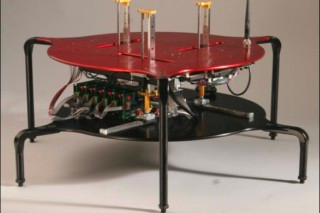


August 6, 2012
ALERT researchers at Northeastern University partnered with Square One Systems Design to win a National Science Foundation Engineering Research Center – Small Business award in automated landmine detection. This promising partnership leverages the strengths of academic and industry experts for a project with broad humanitarian and research potential
The partnership involves pairing Square One’s Walking Tri-Sphere (WTS) robot with ALERT’s Ground-Penetrating Radar solution. The WTS robot can autonomously negotiate rugged terrain, making it well suited for operating in a buried explosives environment, but object detection was a missing critical component. ALERT deputy director Carey Rappaport and researcher Jose Martinez are leading the Northeastern team in developing an effective and inexpensive Ground-Penetrating Radar (GPR) solution. If successful, the combined GPR-WTS system will enhance automated characterization of subsurface environments.
Current methods of demining involve slow and dangerous manual probing or use very expensive and often delicate advanced technology. Square One and ALERT hope that this partnership will blaze a path toward fully automated demining operations and serve as a jumping off point to other significant subsurface characterizations.
In addition to the humanitarian benefits, this partnership creates many opportunities for student participation. Graduate and undergraduate students at Northeastern are actively involved in this cutting-edge design project, participating in computational modeling, reconstruction algorithm development, and antenna design and testing aspects.
Northeastern Ph.D.student Margery Hines, working with Carey Rappaport, won judges’ choice in the 2012 National NSF IGERT Online Video & Poster competition for her presentation of a computational study that demonstrated an ability to locate both metallic and non-metallic anti-personnel landmines.

 News
News
 News
News
 News
News